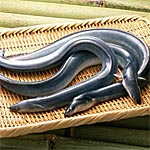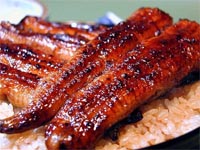Unagi - The Power of the Eel
By Marri Lynn
 If you ask a North American to name all the edible fish they can think of, likely eel will fall at the bottom of the list or not be mentioned at all. If you ask a Japanese person to create the same list, not only will you get a more intriguing variety, but eel will be one of the first mentioned. Annually, Japan consumes up to 130,000 tons of eel. On the hottest day of summer called 'Ushi no hi', many Japanese indulge in the tradition of eating the eel. The slippery fellow has long been associated with stamina among the Japanese, perhaps because of its long migratory trek to spawning grounds.
If you ask a North American to name all the edible fish they can think of, likely eel will fall at the bottom of the list or not be mentioned at all. If you ask a Japanese person to create the same list, not only will you get a more intriguing variety, but eel will be one of the first mentioned. Annually, Japan consumes up to 130,000 tons of eel. On the hottest day of summer called 'Ushi no hi', many Japanese indulge in the tradition of eating the eel. The slippery fellow has long been associated with stamina among the Japanese, perhaps because of its long migratory trek to spawning grounds.
Though eel can hardly be considered quenching, the old concept that the eel can share some of its energetic properties has been confirmed by recent nutritive science. Eel carries a beneficial arsenal of vitamins and proteins within its tender white flesh. Despite the nutritional boons offered by eels, many shy away from this unsung hero of the marine world due to its vicious, serpentine appearance. It's time for us to rediscover the flavorful fish, and embrace it once again within the common umbrella of North American cuisine.
Before the eel fell out of favor within the collective family of western foods, they were a part of our common past. Our European ancestors frequently saw it in their cookpots, and welcomed it on their plates. The slimy creature dwelt in abundance within English rivers, waiting to be speared and brought home to be prepared in any number of ways. Within the pages of Medieval and Renaissance cookbooks, one can find eels baked in red wine, eel pies, simple eel fried in butter with parsley, eel stews, and more. A modern housewife might balk at what to do with an already cleaned, gutted and filleted eel while only a few hundred years ago an English peasant wasn't worth her salt if she didn't know how to turn a basket full of live, writhing eels into a delicious meal for husband, family, and potential guests.
Diners could eat in confidence that they were enjoying a high source of protein, without straining their host's household resources. Eel was much cheaper than pork or beef, and yet contains more protein per ounce. Though perhaps a little uglier than salmon or sole, the understated eel still possesses the unsaturated fatty acids which lately have the health-conscious singing the praises of fish in general. With less caloric content than pork and beef, and the prevalence of such vitamins as B12, A, and E, it's a wonder how the homely eel has drifted into obscurity.
Eel has an obscure life-cycle, and it is only recently in 1922 that a Dutch oceanographer discovered the undersea spawning ground in the North Atlantic Ocean. Eel cannot be farmed in the conventional sense due to its migratory lifestyle, and eel farms are in reality areas where young eels known as 'elvers' are kept until they reach a marketable size.
The streets of London once echoed with the calls of vendors seeking to sell piping hot eel pies to eager pedestrians. Today one is most likely to find eel for purchase vacuum-wrapped within the freezer of the local Asian supermarket. For those not ready to hunt down a seafood market and face the challenge of dispatching and preparing a fresh eel, Japan of course offers a more convenient option in the form of eel kabayaki. It's a fillet of steamed eel packaged with a dark sauce, ready to be opened and briefly baked atop tinfoil until warm. It can be enjoyed by itself, on a bowl of rice, or in a sushi form.
 I cannot recall exactly where or when I got my first taste of eel, but from that hazy beginning a firm love has formed. I've never been disappointed with the fish's dusky, creamy flesh, and I've enjoyed it most often simply laid atop a pad of rice, held there by a band of sushi seaweed. This style of sushi is known as nigiri, and with such simple embellishments, the flavor of eel shines.
I cannot recall exactly where or when I got my first taste of eel, but from that hazy beginning a firm love has formed. I've never been disappointed with the fish's dusky, creamy flesh, and I've enjoyed it most often simply laid atop a pad of rice, held there by a band of sushi seaweed. This style of sushi is known as nigiri, and with such simple embellishments, the flavor of eel shines.
Gobbling down one bite-sized morsel a little too hastily, I was suddenly introduced to one of the little perils in consuming eel; even within the commercial fillets, there can still be tiny cartilaginous bones waiting to trip up an overzealous eater. Such as I, gulping down my nigiri with only the pretense of chewing.
I didn't realize anything was amiss initially, and went on my way. But a moment or two later an irritating pang resounded in my throat. I tried the old western tricks; swallowing water, making an odd noise in the back of my throat with hopes to dislodge it. My life wasn't in peril, but the little bone was making a nuisance of itself.
Luckily, I had Japanese friends nearby to rescue me. Having grown up eating the fish, naturally they knew of the way to foil trapped fishbones. The solution presented was initially a little daunting. One has to take a sizable portion of rice, and compress it into a pellet. And then, the daunting part - swallow it whole without chewing. I tried this, twice, but my Japanese audience declared I wasn't making the pellet big enough. Trying to save myself from choking further, I didn't see how stuffing an enormous pellet of rice down my throat was really going to help matters. I managed at last to swallow one great pellet, and it did the trick. After a brief swallow of water to soothe my poor throat, I realized the nuisance was gone. The great pill of rice had snagged the bone on the way down, drawing it into my gullet.
That slightly unpleasant and educational encounter wasn't nearly enough to stop me from loving eel. For those ready to set aside unspoken grudges and have a taste, be advised it's more cost effective to purchase a package of eel kabayaki to take home yourself than to go to a restaurant. An unagidon, eel on a bowl of rice, costs just under nine dollars at Sakura Grocery, while a package of kabayaki offers almost twice the amount of eel for the approximately the same price, and will keep in the freezer to satisfy sudden cravings.
For those wary food adventurers not yet willing to commit to consuming the entire eel, Daidoco Café offers a smaller but equally scrumptious unagidon for around five dollars. Of course, those bite-sized unagi nigiri are available at most sushi restaurants.
Remember to keep some rice nearby, just in case.
(Note: Sakura Grocery and Daidoco Café are in Victoria, BC, Canada)
- Related article on Japanese Food
